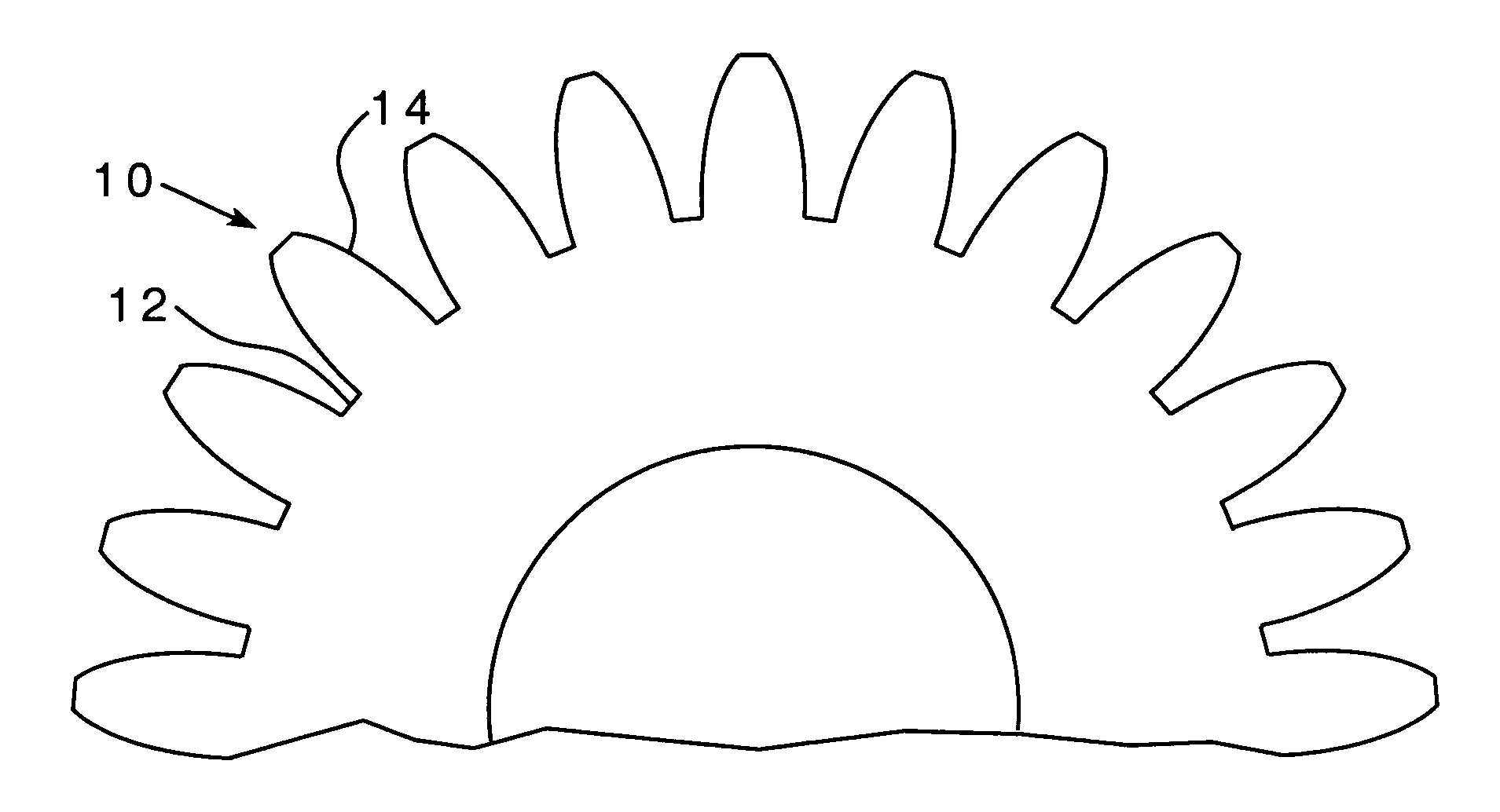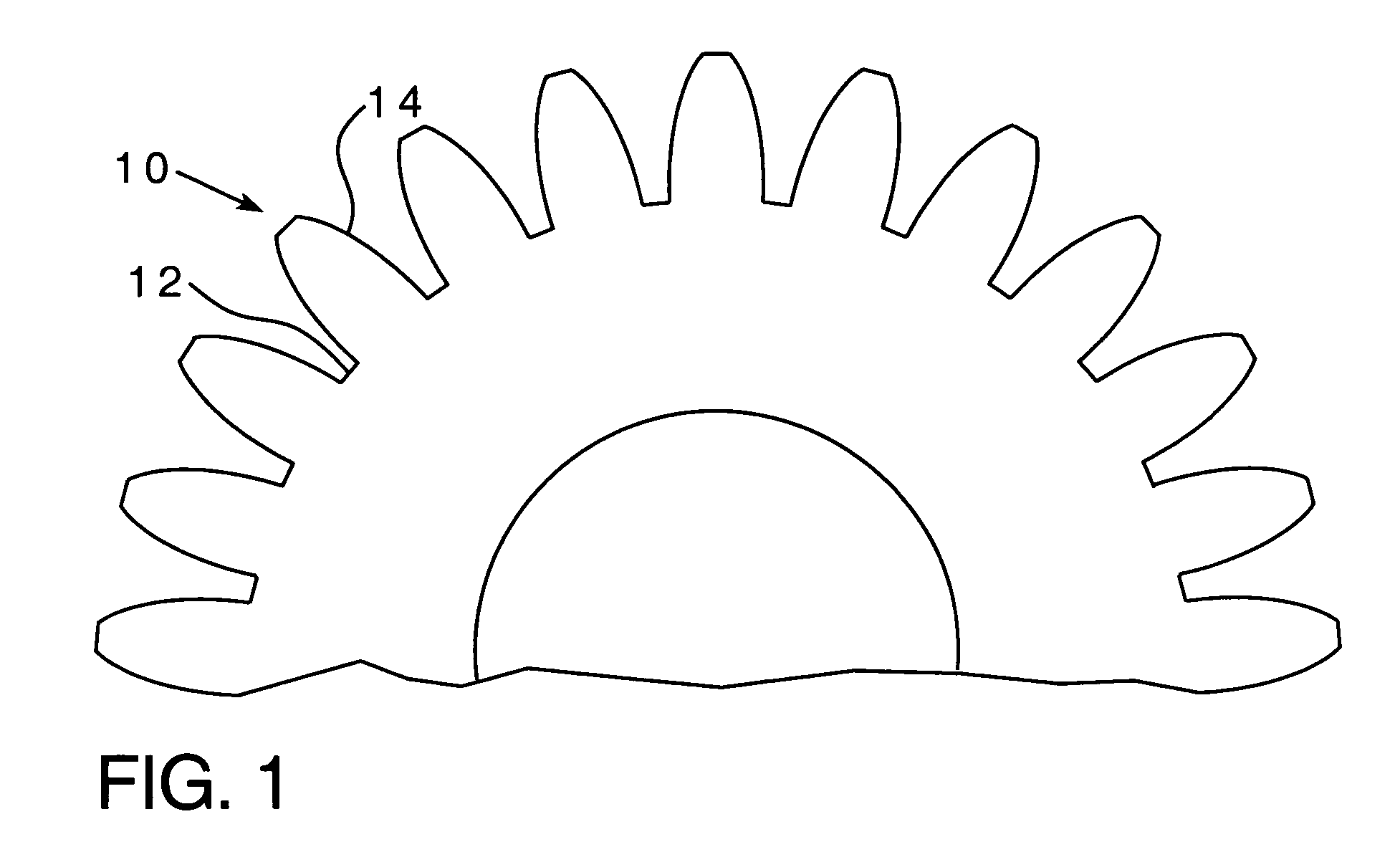Powder metal materials and parts and methods of making the same
a technology of metal materials and parts, applied in the field of forming powder metal materials and powder metal parts, can solve the problems of difficult to achieve sufficient depth and uniformity of densification, poor effect of method on irregularly shaped surfaces such as gear teeth, sprockets, and cams
- Summary
- Abstract
- Description
- Claims
- Application Information
AI Technical Summary
Benefits of technology
Problems solved by technology
Method used
Image
Examples
example 1
[0081]A gear was formed according to one non-limiting embodiment of the invention by compacting a powder metal composition comprising about 99.25 weight percent QMP 4401 and about 0.75 weight percent EBS wax lubricant at about 40 tsi to a density of 7.0 g / cc. The gear was then sintered at a temperature of about 2080° F. for about 20 minutes. Thereafter, portions of the surface of the gear in the tooth root region and the tooth flank region were densified by shot peening. Shot peening involved impacting with SAE S70 shot (i.e., shot having a diameter ranging from about 0.016 to about 0.046 inches) for about 10 minutes at a pressure of 100 psi. After shot peening, the densified portions of the surface of the gear were uniformly densified to a density of 7.8 g / cc (which is about 99.1 percent of the theoretical density of the powder metal part) to a depth of 0.005 inches. Further, after shot peening, the part was sized at 55 tsi. After sizing, the core had a density of 7.5 g / cc (which i...
example 2
[0083]Three sets of 4600 steel-base spur gears (described below) were prepared by molding a powder compact to a green density of 6.8 g / cc and sintering at about 2080° F. for about 20 minutes in a N2-10% H2 atmosphere. The same powder metal composition was used to form each set of parts.
[0084]The first set of parts (SET 1) was formed according to conventional means, except that the powder forging was controlled to achieve core density of 7.6 g / cc and a surface density of 7.55 g / cc as measured using image analysis.
[0085]The second set of parts (SET 2) was formed according to one non-limiting embodiment of the present invention by post-sinter shot peening portions of the surface of the part prior to powder forging, with all other process steps performed as described above. The shot peening process comprised impacting with SAE S70 shot (i.e., shot having a diameter ranging from about 0.016 to about 0.046 inches) for about 10 minutes at a pressure of 100 psi. After shot peening, the dens...
example 3
[0090]Two low carbon steel gears were formed by molding at 40 tsi and sintering at 2080° F. for 20 minutes in a N2-10% H2 atmosphere. One gear was subsequently heated to 1800° F. in a protective atmosphere and transferred to a die held at 600° F. prior to powder forging at 60 tsi. As shown in FIG. 3, finger oxides 32 were present near the surface (generally indicated as 30) of the first gear after forging.
[0091]The second gear was processed under similar conditions to the first gear; however, portions of the surface of the second gear were shot peened as described above in Example 1 after sintering and prior to reheating and forging. As shown in FIG. 4, no finger oxides were present near the surface (generally indicated as 40) of the second gear after forging.
PUM
| Property | Measurement | Unit |
|---|---|---|
| diameter | aaaaa | aaaaa |
| diameter | aaaaa | aaaaa |
| depth | aaaaa | aaaaa |
Abstract
Description
Claims
Application Information
 Login to View More
Login to View More - R&D
- Intellectual Property
- Life Sciences
- Materials
- Tech Scout
- Unparalleled Data Quality
- Higher Quality Content
- 60% Fewer Hallucinations
Browse by: Latest US Patents, China's latest patents, Technical Efficacy Thesaurus, Application Domain, Technology Topic, Popular Technical Reports.
© 2025 PatSnap. All rights reserved.Legal|Privacy policy|Modern Slavery Act Transparency Statement|Sitemap|About US| Contact US: help@patsnap.com



